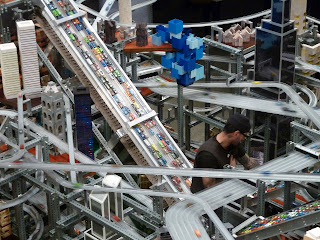Anyone who was once a child--or is still a child!--will get a huge kick out of the installation of Chris Burden's Metropolis at the Los Angeles County Museum of Art. At yesterday's preview for the media, the enchantment was evident all around. And why not? It's a "small world,"
room-sized fantasy city of the future, complete with monumental high rises, apartment and office buildings, old-fashioned trolley cars and trains, sedate in their movement along small-guage tracks when compared to the headlong dash of computer-directed automobile traffic.
As Burden posited in his brief preliminary remarks, city traffic in the future may well all be remote-controlled, fast and driverless, as commuters head each in their separate vehicles to their destinations. The artist's vision, here, is a mind-bendingly intricate system of roller-coaster tracks, where closely serried, undulating lines of tiny, colorful Tinker Toy cars are hoisted up long, steep ramps...

(The pictures, and the regrettably poor quality video below, are all mine. In this instance, LACMA did not object to photography. Visit LACMA's site, linked above, for better images and videos.)
... and released at the top to whizz downhill at breakneck speed...

... each at its own pace. I saw no parking lot or unloading area where cars could come to rest for even an instant, so the impression is of uninterrupted mechanized mania, where actual human beings are hidden from sight in their vehicles, behind the steel and glass exteriors of office towers, or in their tall apartment buildings. Metropolis seems to exist for no other purpose than its own unendingly busy existence.
In a contemporary art world where so much of what is shown in galleries and museums requires being in on the conventions and the current trends, Chris Burden has consistently produced work that, at one level at least, invites even the uninitiated to participate--sometimes, indeed, with anger or revulsion; but often, as in this case, with the kind of pleasure that we all felt as kids--the pleasure involved in putting things together, building with blocks and racing cars or running model trains. In this respect, Burden speaks to the child in all of us who loves to play. At the purely emotional level, his work evokes an immediate response from these depths of memory.
At another level entirely, and again like much of Burden's work, Metropolis invites the serious intellectual engagement of the adult mind. It asks us to reflect on the way in which we live our lives in the contemporary world, the constant blur of beehive noise and speed, the architectural environment of the modern city...
... with all its seductive activity, its peculiar beauty--and its nightmare potential for alienation of the human soul. It asks us to reflect, also, on the way we are now trending toward a future that holds not only promise, but also dread. The vehicles, here, have no destination: they simply follow, mindlessly, their predestined tracks. Humanity is lost in the labyrinth of the structures of its own creation.
Intriguingly, I also found in Metropolis a fascinating model of the nature and workings of the mind. Perhaps its the Buddhist in me. Its intricately assembled solid structures suggest, to me, the way in which we build prejudices and fixed ideas; its multiple, confusing and conflicting tracks, the patterns of our thoughts; like those little cars...

... they assemble in some dark recess of the mind, a hundred disparate thoughts and memories, rise up slowly into consciousness, then scatter precipitously every which way, racing through the mind before disappearing once more into forgotten passages and tunnels. To contemplate the piece was to watch the human mind at work, and to recognize its delusions and futilities.
There is, clearly, much more to be said about "Metropolis." It opens itself generously to each new visitor's responses. Enough to say here that it's a visual delight, a kinetic sculpture of great fascination and originality, a painting in constant motion, a conceptual work that, along with the eye, engages heart and mind in its epic sweep. Worth a visit.
(The result of years of work, and originally installed in the artist's studio, "Metropolis" will now be installed long-term at LACMA. It's important, for obvious reasons, to see the piece in operation: times are limited because it requires a full-time, skilled attendant, so visitors should be forewarned to check the museum's site ahead of time for the schedule, to avoid disappointment.)








No comments:
Post a Comment